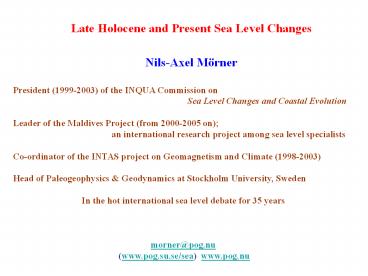Late Holocene and Present Sea Level Changes - PowerPoint PPT Presentation
Title:
Late Holocene and Present Sea Level Changes
Description:
Leader of the Maldives Project (from 2000-2005 on) ... curve of the Maldives; present level reached ... The Maldives: No rise but stability and fall ~1970 ... – PowerPoint PPT presentation
Number of Views:222
Avg rating:5.0/5.0
Title: Late Holocene and Present Sea Level Changes
1
Late Holocene and Present Sea Level Changes
Nils-Axel Mörner President (1999-2003) of t
he INQUA Commission on Sea Level
Changes and Coastal Evolution
Leader of the Maldives Project (from 2000-2005 o
n) an international research proj
ect among sea level specialists
Co-ordinator of the INTAS project on Geomagnetis
m and Climate (1998-2003) Head of Paleogeophysi
cs Geodynamics at Stockholm University, Sweden
In the hot interna
tional sea level debate for 35 years
morner_at_pog.nu
(www.pog.su.se/sea) www.pog.nu
2
(No Transcript)
3
(No Transcript)
4
Many variables control the stability of a
shoreline
5
Sea Level Rose for glacial eustatic reasons up t
o about 5000 BP. after that, global sea level h
as been dominated by the redistribution of ocean
water masses (and by that ocean stored energy)
In a feed-back coupling in the interchange of
angular momentum (rate of rotation) between the
hydrosphere and solid Earth by that driving the
ocean surface circulation and its
redistribution of water masses heat (sea level
paleoclimate)
6
Horizontal Eustasy Ocean Level Redistribution
I have argued for over 20 years
that sea level is changing drastically
due to redistribution of water masses
over the globe and even claimed that this is the
dominating factor for the last 5000 years
Satellite altimetry records this differential di
stribution of water massed between 1993 and 2000
Despite the fact that we do not accept the
proposed on-going rise in sea level
7
(No Transcript)
8
Present-to-Future Sea Level Changes methods
used and values obtained
9
The combined observational records (in mm/year)
for the last 300 years. It shows variations ups
and downs but no trend. For year 2100, INQUA g
ives predictions in line with this record,
whilst the IPCC scenarios lie far above way off
observational data
10
The new sea level curve of the Maldives present
level reached 4000 BP, sea level strongly
oscillating for regional dynamic reasons, a drop
in sea level 1970, no rise in the last 30 years.
11
At 1970 Sea Level fell some 20 cm Causing ero
sion with sand deposition outward, downward Lea
ving an old fossil shore and an old overgrewing
surface of grey weathered corals.
The present shore has remained stable for 30
years
12
Exploring some notorious sites
claimed to be in a flooding mode
The Maldives No rise but stability and fall 19
70 Tuvalu No rising trend (tide gauge date from
1978) Vanuatu No rising trend (tide gauge data f
rom 1993) Venice No acceleration (rather the opp
osite 1970) Eastern Mediterranean Rise due to p
recipitation increase
13
Satellite altimetry is a new and important means
of recording sea level. The 1993-1999 record show
NO rising trend. Just a variability around a zer
o level (blue) a major ENSO event (yellow).
This data set was presented on the TOPEX/POSEIDON
web-page, in their publications, and used by me
in my paper in Global and Planetary Changes, vol.
40, 2004, p. 49-54
14
In 2003, a totally new record appeared on the
web-page Now there was a trend of 2.3 mm/year. T
his trend, however, comes from selected tide
gauge records not satellite altimetry measurement
s
15
(No Transcript)
16
The flooding scenario of IPCC does not concur
with observational sea level facts. Therefore, it
must be called-off as a mistake.
Today, we favour a 2100 value of 5 cm 15 cm
17
(No Transcript)
18
There is no global sea level rise going on
that will flood islands and low-lying coasts in
the near-future
It is high time to face available observational
facts, discard untenable model scenaria and star
t discussing real threats in the real world
19
Today I launch a short book entitled The Greate
st Lie Ever Told unfortunately I have to charge
15 Australian dollars for it































